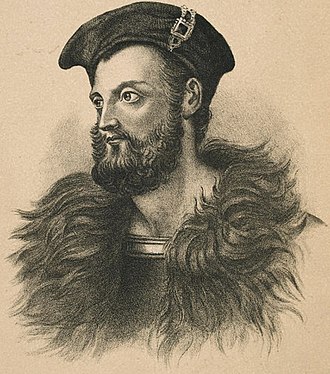6 November 1649: General Owen Roe O’Neill/Eoghan Rua Ó Néill died at Cloughoughter/ Cloch Uachtar Castle in County Cavan on this day. He was the leader of the last Gaelic Army of the North and one of Ireland’s greatest Generals. He was born circa 1585/90 and was the son of Art Mac Baron O'Neill and the nephew of the Great Aodh O'Neill, the Earl of Tyrone, who led the Catholics during the Nine Years War (1594-1603).
He was sent to Spain at an early age and joined the Irish Brigade of the Spanish Army. He was an able and talented soldier and destined to command at a high level. He never forgot his Homeland though and kept in contact with those in Ireland who wished to overthrow the religious and civil persecutions that the Irish Catholic People suffered under. His greatest test came in 1640 when he was in command of the City of Arras (then part of the Spanish Netherlands) that was besieged by an overwhelming French Army. With just 1,500 men he held out against the odds for eight long weeks despite many assaults on the Citadel. Forced eventually to ask for terms he was allowed to march out with the Honours of War.
But the following year the Rising of 1641 erupted and he decided that his place was back in Ireland and the head of Irish soldiers. Accompanied by a cluster of trusted officers he sailed in a tiny fleet to make it back here in July 1642. Shocked by the mayhem and indiscipline he encountered he quickly reformed the men placed under his care into a cohesive and efficient armed force. Despite this he was defeated at the Battle of Clones in 1643 but he learnt his lesson of never again meeting the enemy on anything less than favourable terms. In 1645 the Papal Nuncio, Archbishop Rinuccini, arrived with Arms & specie to breath life into the Confederate Armies, of which O’Neill’s force constituted a semi autonomous component. This was to be a turning point in the struggle to gain mastery over the North.
In the early summer of 1646 he achieved his greatest Victory when he took the field against the Anglo-Scots of Ulster under the command of Sir Robert Monro. At the Battle of Benburb on 5 June of that year he defeated and overwhelmed a British Army led by Monro. It was the biggest set-piece battle of the Confederate War and a major setback for the British in Ulster, but, split by internal divisions and engaged in futile negotiations with the Duke of Ormond, the Confederates failed to follow up the military advantage of O'Neill's victory. The Catholics were hopelessly divided between those who wished to reach an agreement with King Charles I to allow for a level of toleration for the Catholic religion and those who would settle for nothing less than the removal of all impediments to the open practise of Catholicism.
Such internal pressures eventually led to what was in effect an internal Civil War in which Owen Roe O’Neill was called upon to move south to back the Papal Nuncio in his implacable opposition to the Peace Treaty with the Protestant Viceroy Ormond. In September 1646, O'Neill marched to Kilkenny to support Rinuccini, who then forced the Supreme Council to agree to a Confederate attack on Dublin with the Ulster and Leinster armies. Owen Roe O’Neill’s Ulster Army swept down upon the plains of Meath, burning homesteads and destroying the crops in an effort to hamper the Royalist War effort. But the two pronged assault on Dublin fizzled out as the City was well protected by strong walls and a determined garrison. The onset of Winter then put a stop to any chance of a prolonged Siege.
During 1647, moderate members of the Supreme Council succeeded in relegating O'Neill to service in Connacht and relied upon Preston to protect Kilkenny with the Leinster army. In 1648 the Confederates again fell out amongst themselves. O'Neill remained loyal to Rinuccini. In June 1648, he declared war on the Supreme Council and marched against Kilkenny. Although he failed to capture the Confederate capital, he spent most of the summer pillaging the surrounding country and manoeuvring against Inchiquin and Confederate forces in Leinster. In January 1649 Archbishop Rinuccini departed from Ireland in despair. O'Neill refused all approaches to join the Royalist-Confederate coalition because Ormond would not commit himself to promising the restoration of Irish lands in Ulster as O'Neill demanded.
By then King Charles I had been executed and Oliver Cromwell was ready to lead a well equipped army to Ireland to attempt a Re Conquest. Despite negotiations O’Neill was wary of the shaky coalition of Catholic Confederates and Protestant Royalists led nominally by the Duke of Ormond - a rather shady character. Neither side trusted the other and O’Neill was effectively isolated from events in the rest of the Country. Indeed so weak had become O’Neills position and so starved was he of supplies that he made an arrangement with the Parliamentarians Colonel Monck and later with Sir Charles Coote in order to stop the lands he held been overrun by the Ulster Scots, who now fought under the King’s Charles II banner. General O’Neill, perhaps unwisely, took up an invitation to dine in Derry with Sir Charles Coote, the Governor of the City. Soon afterwards he became ill, took a fever and died. His followers quickly suspected treachery and perhaps they were right. If so it was devious but effective way of the English Parliament to rid itself of one of the most able soldiers this Country has ever produced. He is buried in an island in Lough Oughter in Cavan.

No comments:
Post a Comment